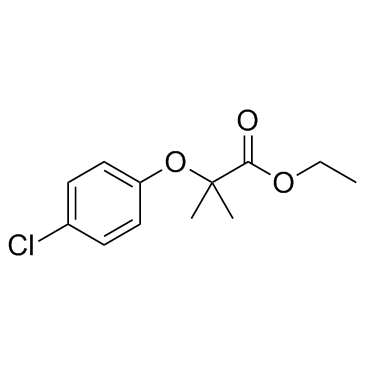clofibrate

clofibrate structure
|
Common Name | clofibrate | ||
|---|---|---|---|---|
| CAS Number | 637-07-0 | Molecular Weight | 242.699 | |
| Density | 1.1±0.1 g/cm3 | Boiling Point | 274.8±0.0 °C at 760 mmHg | |
| Molecular Formula | C12H15ClO3 | Melting Point | N/A | |
| MSDS | Chinese USA | Flash Point | 115.1±19.9 °C | |
| Symbol |


GHS05, GHS07 |
Signal Word | Danger | |
|
Cheminformatics analysis of assertions mined from literature that describe drug-induced liver injury in different species.
Chem. Res. Toxicol. 23 , 171-83, (2010) Drug-induced liver injury is one of the main causes of drug attrition. The ability to predict the liver effects of drug candidates from their chemical structures is critical to help guide experimental drug discovery projects toward safer medicines. In this st... |
|
|
Translating clinical findings into knowledge in drug safety evaluation--drug induced liver injury prediction system (DILIps).
J. Sci. Ind. Res. 65(10) , 808, (2006) Drug-induced liver injury (DILI) is a significant concern in drug development due to the poor concordance between preclinical and clinical findings of liver toxicity. We hypothesized that the DILI types (hepatotoxic side effects) seen in the clinic can be tra... |
|
|
The Japanese toxicogenomics project: application of toxicogenomics.
Mol. Nutr. Food. Res. 54 , 218-27, (2010) Biotechnology advances have provided novel methods for the risk assessment of chemicals. The application of microarray technologies to toxicology, known as toxicogenomics, is becoming an accepted approach for identifying chemicals with potential safety proble... |
|
|
Developing structure-activity relationships for the prediction of hepatotoxicity.
Chem. Res. Toxicol. 23 , 1215-22, (2010) Drug-induced liver injury is a major issue of concern and has led to the withdrawal of a significant number of marketed drugs. An understanding of structure-activity relationships (SARs) of chemicals can make a significant contribution to the identification o... |
|
|
A predictive ligand-based Bayesian model for human drug-induced liver injury.
Drug Metab. Dispos. 38 , 2302-8, (2010) Drug-induced liver injury (DILI) is one of the most important reasons for drug development failure at both preapproval and postapproval stages. There has been increased interest in developing predictive in vivo, in vitro, and in silico models to identify comp... |
|
|
Chemical genetics reveals a complex functional ground state of neural stem cells.
Nat. Chem. Biol. 3(5) , 268-273, (2007) The identification of self-renewing and multipotent neural stem cells (NSCs) in the mammalian brain holds promise for the treatment of neurological diseases and has yielded new insight into brain cancer. However, the complete repertoire of signaling pathways ... |
|
|
Evaluation of a published in silico model and construction of a novel Bayesian model for predicting phospholipidosis inducing potential.
J. Chem. Inf. Model. 47 , 1196-205, (2007) The identification of phospholipidosis (PPL) during preclinical testing in animals is a recognized problem in the pharmaceutical industry. Depending on the intended indication and dosing regimen, PPL can delay or stop development of a compound in the drug dis... |
|
|
Neural computational prediction of oral drug absorption based on CODES 2D descriptors.
Eur. J. Med. Chem. 45 , 930-40, (2010) A neural model based on a numerical molecular representation using CODES program to predict oral absorption of any structure is described. This model predicts both high and low-absorbed compounds with a global accuracy level of 74%. CODES/ANN methodology show... |
|
|
Multi-target spectral moment QSAR versus ANN for antiparasitic drugs against different parasite species.
Bioorg. Med. Chem. 18 , 2225-31, (2010) There are many of pathogen parasite species with different susceptibility profile to antiparasitic drugs. Unfortunately, almost QSAR models predict the biological activity of drugs against only one parasite species. Consequently, predicting the probability wi... |
|
|
Prediction of drug intestinal absorption by new linear and non-linear QSPR.
Eur. J. Med. Chem. 46 , 218-28, (2011) In order to minimize the high attrition rate that usually characterizes drug research and development projects, current medicinal chemists aim to characterize both pharmacological and ADME profiles at the beginning of drug R&D initiatives. Thus, the developme... |